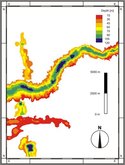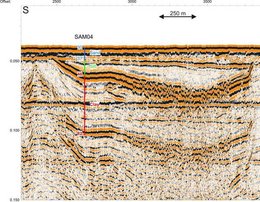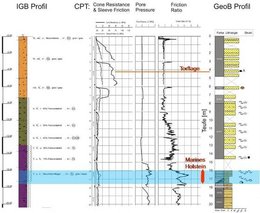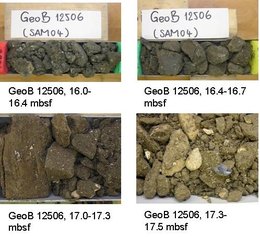Die Inhalte dieser Seite sind leider nicht auf Deutsch verfügbar.
Seitenpfad:
Project: Formation and infill of buried Pleistocene tunnel-valleys in the North Sea
T. Mörz, D. Hebbeln, H. Keil,
A. Bartholomä, J. Ehlers, T. Hanebuth, D. A. Hepp, T. Schwenk, V. Spieß
The release of meltwater from the margins of the Late Quaternary Fennoscandian ice sheets resulted in complex networks of (now buried) Pleistocene tunnel-valleys that extend beneath large parts of the North Sea and the adjacent northern European lowlands. Deeply incised (100-500 m) into mostly Neogene sediment strata, they form a dominant architectural element of the North Sea sedimentary basin and are a primary cause of small scale lithological heterogeneities. Offshore mapping based on seismic surveys is far from complete, but has provided evidence of multiple generations of buried valleys, inferred to record at least three successive cycles of continental glaciation and interglacial marine transgression. The largest known buried valleys lie in and adjacent to the southern North Sea and have been tentatively correlated to the mid-Pleistocene Elsterian glaciation. The recent discovery by MARUM scientists of a so far unknown major E-W trending buried valley in the SE North Sea poses new multi-disciplinary questions with regard to the ages of cross-cutting features, their infill architecture and lithology, the orientations and dynamics of former ice margins, the number and nature of interglacial marine transgressions and the mitigation of geotechnical risks. The latter is of economic importance as lithological heterogeneities in shelf sediments induced by such valleys, common features also in other formerly glaciated regions, have recently gained attention in offshore wind park planning as potential geotechnical risks.
A. Bartholomä, J. Ehlers, T. Hanebuth, D. A. Hepp, T. Schwenk, V. Spieß
The release of meltwater from the margins of the Late Quaternary Fennoscandian ice sheets resulted in complex networks of (now buried) Pleistocene tunnel-valleys that extend beneath large parts of the North Sea and the adjacent northern European lowlands. Deeply incised (100-500 m) into mostly Neogene sediment strata, they form a dominant architectural element of the North Sea sedimentary basin and are a primary cause of small scale lithological heterogeneities. Offshore mapping based on seismic surveys is far from complete, but has provided evidence of multiple generations of buried valleys, inferred to record at least three successive cycles of continental glaciation and interglacial marine transgression. The largest known buried valleys lie in and adjacent to the southern North Sea and have been tentatively correlated to the mid-Pleistocene Elsterian glaciation. The recent discovery by MARUM scientists of a so far unknown major E-W trending buried valley in the SE North Sea poses new multi-disciplinary questions with regard to the ages of cross-cutting features, their infill architecture and lithology, the orientations and dynamics of former ice margins, the number and nature of interglacial marine transgressions and the mitigation of geotechnical risks. The latter is of economic importance as lithological heterogeneities in shelf sediments induced by such valleys, common features also in other formerly glaciated regions, have recently gained attention in offshore wind park planning as potential geotechnical risks.

To what extent are well-known N-S trending buried Pleistocene valleys in the SE-North Sea cross-cut by younger, but E-W trending tunnel-valleys?
Deep (>100-500 m) Pleistocene tunnel-valleys beneath the northern European lowlands (Denmark, N-Germany, Netherlands) and the SE North Sea commonly follow an overall N-S trend and their infill is capped by varying thicknesses of Late Elsterian Lauenburg Clay. Consequently, the formation of these valleys has been assigned to the preceding Elsterian glaciation. Similar structures formed during subsequent glaciations, although they are less extensive and not so deeply incised. The newly discovered E-W trending valley in the SE North Sea is more than 35 km long and apparently crosscuts older N-S trending valleys. Although exceptional for the moment, the presence of additional such valleys is very likely, taking into account the poor mapping status of the SE North Sea. As tunnel-valleys are thought to form by melt water drainage beneath and perpendicular to ice sheet margins, an E-W trending post-Elsterian valley in the SE North Sea implies a N-S trending ice margin of Saalian (?) age, which previously has not been proposed for the German North Sea sector but would fit observations in the Dutch sector. 2D/3D seismic investigations of the extent, shape, infill architecture and crosscutting relationships of Pleistocene buried valleys will be an important contribution to resolve the existing inconsistencies in describing past ice sheet dynamics in this region.

Figure 1. Seismic section through the recently discovered E-W trending buried valley in the German Bight.
Do different infill successions of N-S and E-W trending Pleistocene buried valleys in the SE-North Sea reflect different formation and infill processes?
According to seismic investigations and sparse borehole information, most buried valleys in the North Sea and the adjacent northern European lowlands are filled with a glaciofluvial backfill, deposited close to the retreating ice margin. Their upper parts often contain also younger well-layered muddy glaciolacustrine and/or glaciomarine sediments deposited during subsequent interglacial transgressions and glacial advances. Taking advantage of extensive (mainly industrial) core material and in-situ logging data resulting from wind farm site surveys, the infill lithologies, and thus the infill histories, of N-S and E-W trending valleys will be analyzed. By determination of the maximum pre-consolidation pressure the infill experienced, the ice and sediment loading history of these sequences can be assessed, thus allowing an estimation of e.g. the maximum thickness of Saalian ice advances having overridden the Elsterian and Holsteinian valley fills. In contrast, infills deposited just after the Saalian glaciation should not show any overcompaction as the Weichselian glaciation did not reach the SE North Sea.

Figure 2. Geotechnical data from a drill core obtained from the E-W trending valley.
Did the Holsteinian and Eemian transgressions in the North Sea differ from the Holocene transgression with respect to timing, development and rate of sea level rise?
While some information on the Holocene transgression of the SE North Sea has been compiled recently, there is hardly any information on details on the Holsteinian and Eemian transgressions following the Elsterian and Saalian glacials, respectively. Only the extensions of the Holsteinian and Eemian maximum marine inundations have been mapped based on the presence of marine sediments. However, as the last deglaciations and interglacial stages differed markedly in their developments as deduced from orbital parameters, the related transgressions into the North Sea were probably quite different from the Holocene transgression. First indications for earlier onsets of the Holsteinian and Eemian transgressions in the interglacial compared to the Holocene were deduced from terrestrial palynological investigations. Remnants of these older transgressive sequences are commonly eroded by glacial advances during the following Saalian and Weichselian glaciations, but are partly preserved in the Pleistocene buried valleys. To answer this question, absolute dating of Holocene, Eemian, and Holsteinian transgressive sequences from different depth horizons picked from drill cores both in the SE and in the central North Sea will provide information on the development of the individual postglacial transgressions in the North Sea.

Figure 3. Samples taken from a drill core through the E-W trending valley.


